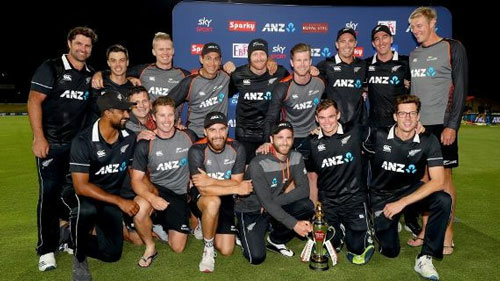Mount Maunganui
New Zealand consigned India to their first bilateral ODI whitewash in more than 22 years*, riding on the efforts of a second-string attack missing Trent Boult, Lockie Ferguson and Matt Henry. Hamish Bennett’s four-for and some tight bowling around him made sure India managed only 296 despite their biggest gain of the series: a middle-order core of KL Rahul and Shreyas Iyer.
New Zealand made the chase seem more difficult than it should have been after a 106-run opening stand between Henry Nicholls and Martin Guptill.
Regular wickets, though, brought back memories of the T20I series debacle, but Tom Latham and a charmed Colin de Grandhomme saw them through from 220 for 5.
India might have lost the ODI series, but in Rahul they have solidified a No. 5 to fill the hole left by Yuvraj Singh and MS Dhoni. Rahul had already shown he could hit hard, hit from ball one and hit for a long time, but on Tuesday, he rescued India from 62 for 3 to score his fourth ODI century. And he did so without eating up balls at the start of his 113-ball 112. Rahul stayed at the wicket for 34.3 overs during which time India scored 207 for 2. Around that stay, though, New Zealand – not great in the field, mind you – managed to cause enough damage to restrict India to 296 for 7 despite the score reading 269 for 4 in the 47th over.
If the similarities were not enough already, Rahul joined Rahul Dravid as the only India wicketkeeper with an ODI century outside Asia. Both were naturalised wicketkeepers who batted below their preferred position to suit the team’s needs. Incidentally, the last time an India batsman scored a hundred from No. 5 or lower was when Dhoni and Yuvraj were batting together, in January 2017 against England. That Cuttack ODI was also the last time India had crossed 290 with the top three’s contribution being under 20%. Not just Rahul, Nos. 4 and 6 around him played their role: Iyer scored a near-run-a-ball 62, and Manish Pandey made sure the runs kept coming with his 42 off 48 from 162 for 4.
The day, though belonged to the New Zealand bowlers. Kyle Jamieson continued his impressive beginning by bowling Mayank Agarwal early, beating the outside edge after having gone past the inside one in the previous game. Virat Kohli played an uncharacteristic innings, getting beaten by wide deliveries early before hitting out to only the seventh ball he faced. This was the earliest he had hit a six in India’s innings. Kohli’s innings didn’t continue for long, though, as he cut Bennett straight to third man. Prithvi Shaw, looking in great touch once again, gave it away by running himself out, bringing in Rahul to join Iyer.
During their last partnership, in the first ODI of this series, Rahul had sort of carried Iyer, but here Iyer was in better touch. He still kept hitting the ball in the air but never fell too far behind the 100 strike rate. Rahul looked imperious from the time he walked in, square-driving the second ball he faced for four. New Zealand turned to de Grandhomme and James Neesham soon after the early exchanges just like they had done in the first ODI. Runs kept trickling with a Neesham short delivery stopped at Iyer, who could only pop up a catch to short midwicket. The two added 100 in 110 deliveries.
Mitchell Santner missed a run-out of Rahul on 64, and Pandey on 35 but did a good job of keeping a lid on the scoring. From the 39th to the 46th over, India hit only one boundary. There was a slightly strange element of risk aversion for a side only four down.
When Rahul took the risk in the 47th over, Jamieson dropped him at long-off. Bennett, though, got his due reward with a similar chance next ball, with Jamieson hanging on this time. Pandey chose the next ball to try to hit a six, and even he could go only as far as long-on. Bennett’s mix of wide lines, hard lengths and knuckle balls worked well and only 86 came in the last 12 overs.—Agencies










